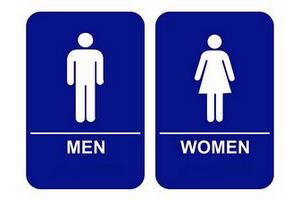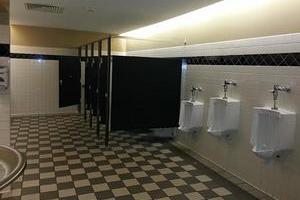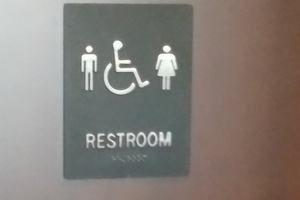You too can poo in this loo
 The first time I heard the acronym LGBTQ I thought it was a new type of sandwich. I know a BLT had bacon, lettuce and tomato on it but, for the life of me, I could not figure out what in the hell the G and Q were on an LGBTQ sandwich. Like any new word, phrase or acronym which comes into the vernacular, only time and exposure will serve to edify pillocks, such as myself, on issues that affect other members of our community. Insofar as LGBTQ issues may be coming into the public sphere, I fear some of the simple or ill-thought-out solutions attempting to confront these new challenges may, themselves, have unforseen consequences. Take, for instance, the challenges faced by the T's of the LGBTQ community who may wish to access public washrooms.
The first time I heard the acronym LGBTQ I thought it was a new type of sandwich. I know a BLT had bacon, lettuce and tomato on it but, for the life of me, I could not figure out what in the hell the G and Q were on an LGBTQ sandwich. Like any new word, phrase or acronym which comes into the vernacular, only time and exposure will serve to edify pillocks, such as myself, on issues that affect other members of our community. Insofar as LGBTQ issues may be coming into the public sphere, I fear some of the simple or ill-thought-out solutions attempting to confront these new challenges may, themselves, have unforseen consequences. Take, for instance, the challenges faced by the T's of the LGBTQ community who may wish to access public washrooms.
For over 50 years, on those occasions that I've been faced with a call of nature, I've managed to find a public washroom before any mishap or malodorous misadventure. And on the vast majority of those instances, I've entered through a door bearing the gender specific sign "MEN". Though considerable time has past since my formative years, I seem to recall the words "BOYS" and "GIRLS" adorning the doors of our primary school washrooms. Bathroom signage has, however, evolved significantly over the years. Words like BOYS, GIRLS, MEN and WOMEN were gradually replaced by signs which included gender specific pictograms and, more recently, by pictogram-only signage. The most recent changes, however, have not been limited to mere signage. The character of the public washrooms themselves have changed.
 Until quite recently, about the only caution a man needed to exercise while using a gender-specific "men's room" was to ensure that neither his shoe laces nor his pant cuffs were dragging on the ground. In many instances the floors, directly in front of the urinals, can be quite an unsavory place. Far too often Pilgrims with short muskets fail to step up to the firing line and their payload falls short of the target. Men's room stalls, on the other hand, tend to be reasonably clean and unscathed.
Until quite recently, about the only caution a man needed to exercise while using a gender-specific "men's room" was to ensure that neither his shoe laces nor his pant cuffs were dragging on the ground. In many instances the floors, directly in front of the urinals, can be quite an unsavory place. Far too often Pilgrims with short muskets fail to step up to the firing line and their payload falls short of the target. Men's room stalls, on the other hand, tend to be reasonably clean and unscathed.
The gender-specific "ladies rooms", of course, do not have urinals. I have rather limited experience when it comes to the ladies' room, having only entered them a few times; once out of necessity (and under instruction) when no other alternative was available, and once out of error. In the latter case, the sign on the door was a representation of an apparent female mouse which I mistook for a rat and had intended to hang one. The point is, that there are no urinals in women's washrooms. and while there was no urine on the floors in front of the toilets I did note lots of pieces of bathroom tissue tossed about the floor, something you'd never see in a men's room. I have asked about a half dozen women about this and they have all confirmed that, indeed, it is not uncommon to see bits of toilet tickets strewn about on the floor of lady's room stalls.
 I'd argue that one consequence of the LGBTQ movement, and the accompanying public awareness and social response, is an emergence, at least at some establishments, of gender-free public washrooms. (Pictured left: Gender-free public washroom at Starbucks, Ottawa.) While the one-size-fits-all approach might strive to seemingly provide a pragmatic solution to the new-found social awareness and sensitivity to issues of gender, efficacy and fiscal conservatism, I fear, may well have introduced unforseen or unanticipated issues. More specifically, I refer to the decline of the urinal.
I'd argue that one consequence of the LGBTQ movement, and the accompanying public awareness and social response, is an emergence, at least at some establishments, of gender-free public washrooms. (Pictured left: Gender-free public washroom at Starbucks, Ottawa.) While the one-size-fits-all approach might strive to seemingly provide a pragmatic solution to the new-found social awareness and sensitivity to issues of gender, efficacy and fiscal conservatism, I fear, may well have introduced unforseen or unanticipated issues. More specifically, I refer to the decline of the urinal.
I have yet to encounter a gender-free washroom which contains both a toilet and a urinal. And I've yet to encounter a gender-free washroom which, as a result, did not boast a piss-ridden floor directly in front of the toilet. Welcome to an era of equality; an era where any gender may sit upon the throne with their pants around their ankles soaking up urine.
Submitted by Mike Oxzore, 06 June 2018